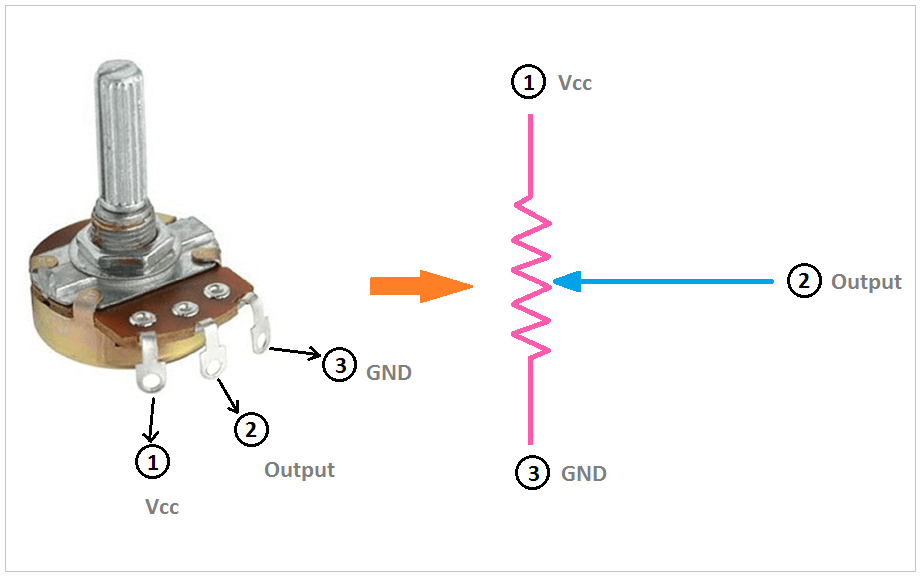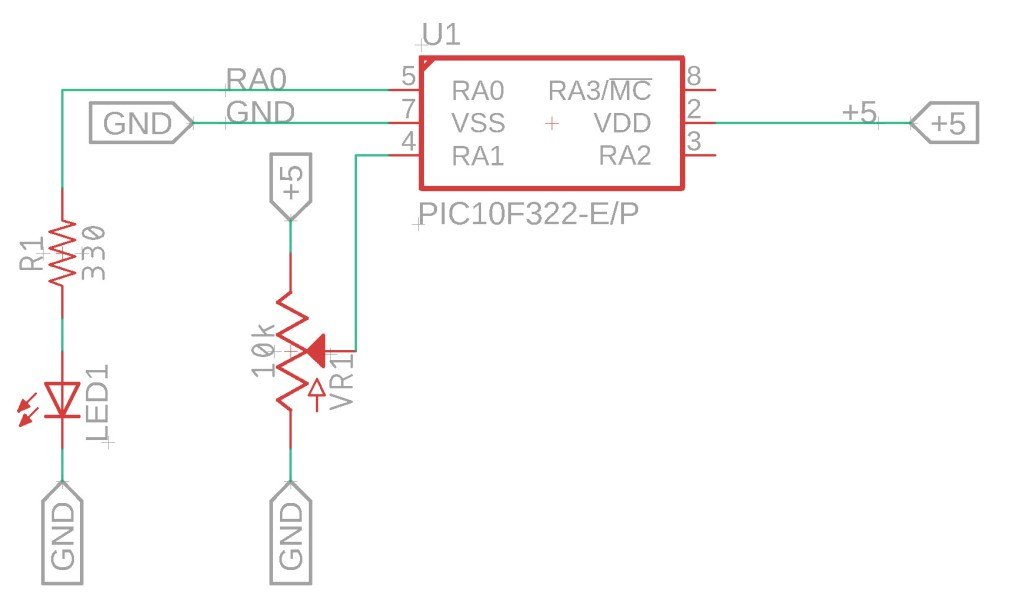The PIC10F322 Analog-to-Digital Converter has three selectable external analog channels. This allows you to convert an analog signal (voltage) to an 8bit value (0 – 255) that you can use – to do whatever you dream up.
Here is the process that enables the ADC on Port.A1 and reads a value.
Configure Port:
- Disable pin output driver
- TRISAbits.TRISA1 = 1; //Make pin Input PORT.A1
- Configure pin as analog
- ANSELAbits.ANSA1 =1; //Enable Analog PORT.A1
Configure the ADC module:
- Select ADC conversion clock
- ADCONbits.ADCS = 0b010;
- //Set Analog conversion clock FOSC/32, since we are running 16Mhz, we need to have a conversion time at or greater 1uS – FOSC/32 will give us 2uS – See Table 15-1 in the PIC10F322 Datasheet
Select ADC input channel
- ADCONbits.CHS = 0b001; //Select the Analog channel – PORT.A1 or AN1
Turn on ADC module
- ADCONbits.ADON = 1;
Start conversion by setting the GO/DONE bit.
- ADCONbits.GO_nDONE = 1; //Start the conversion
Wait for ADC conversion to complete by Polling the GO/DONE bit:
while (ADCONbits.GO_nDONE == 1){
NOP();
}
Read ADC Result.
int adc_value = ADRES;
So, lets put that to code and get something to light a LED when the input voltage goes over a certain value.
The setup has a LED attached to PORT.A0 – which will light when the input voltage value is greater than 128. Anything below that will keep it off.
A 10K potentiometer is attached to PORT.A1 – which is configured as the analog input.
For a quick potentiometer refresher – see the image below. The output is changed by turning the shaft.

The Circuit
Turn the potentiometer will increase or decrease the output voltage – please note that this voltage should be only used for measurement and not to drive the circuit.

The Code
The code has a 1 second delay before reading the ADC again and checking the value.
/*
* File: adc_example.c
* Author: Jamie
*
* Created on 9/14/2021, 8:01 AM
*/
#include <xc.h>
#include <stdint.h>
//Device Configuration
#pragma config FOSC = INTOSC // Oscillator Selection
#pragma config BOREN = ON // Brown-out Reset
#pragma config WDTE = OFF // Watchdog Timer
#pragma config PWRTE = ON // Power-up Timer
#pragma config MCLRE = OFF // MCLR Pin Function Select bit->MCLR pin function is digital input, MCLR internally tied to VDD
#pragma config CP = OFF // Code Protection
#pragma config LVP = OFF // Low-Voltage Programming
#pragma config LPBOR = ON // Brown-out Reset Selection bits
#pragma config BORV = LO // Brown-out Reset Voltage Selection
#pragma config WRT = OFF // Flash Memory Self-Write Protection
//Used to calculate the delay time - Change depending on processor Speed
#define _XTAL_FREQ 16000000 //16Mhz
//Prototypes
void setup(void);
int ADC_Read(void);
void setup(void){
//Set the System Clock - You can change this to match the setting you are looking for
OSCCONbits.IRCF = 0b111; //Set System Clock to 16Mhz
//Pin LED is connected to
TRISAbits.TRISA0 = 0; //Make pin Output Port.A0
ANSELAbits.ANSA0 =0; //Disable Analog Port.A0
LATAbits.LATA0 = 0; //Make output low
TRISAbits.TRISA1 = 1; //Make pin Input Port.A1
ANSELAbits.ANSA1 =1; //Enable Analog Port.A1
//Set Analog conversion clock FOSC/32, since we are running 16Mhz, we need to have a conversion time at or greater 1uS
//FOSC/32 will give us 2uS
ADCONbits.ADCS = 0b010;
//Select the Analog channel - Port.A1 or AN1
ADCONbits.CHS = 0b001;
//Turn on the ADC module
ADCONbits.ADON = 1;
}
void main(void)
{
setup();
while(1){
int ADC_Value = 0;
ADC_Value = ADC_Read();
if (ADC_Value > 128){
LATAbits.LATA0 = 1; //Turn ON LED
}
else{
LATAbits.LATA0 = 0; //Turn OFF LED
}
__delay_ms(1000); //Wait 1 second and do it again
}
}
int ADC_Read(){
//Starts the ADC read and waits until a conversion is complete before returning
//Returns the ADC value
ADCONbits.GO_nDONE = 1; //Start the conversion
while (ADCONbits.GO_nDONE == 1){
NOP();
}
return ADRES;
}Have a Project or Idea!?
I am Available for Freelance Projects
My skills are always primed and ready for new opportunities to be put to work, and I am ever on the lookout to connect with individuals who share a similar mindset.
If you’re intrigued and wish to collaborate, connect, or simply indulge in a stimulating conversation, don’t hesitate! Drop me an email and let’s begin our journey. I eagerly anticipate our interaction!
